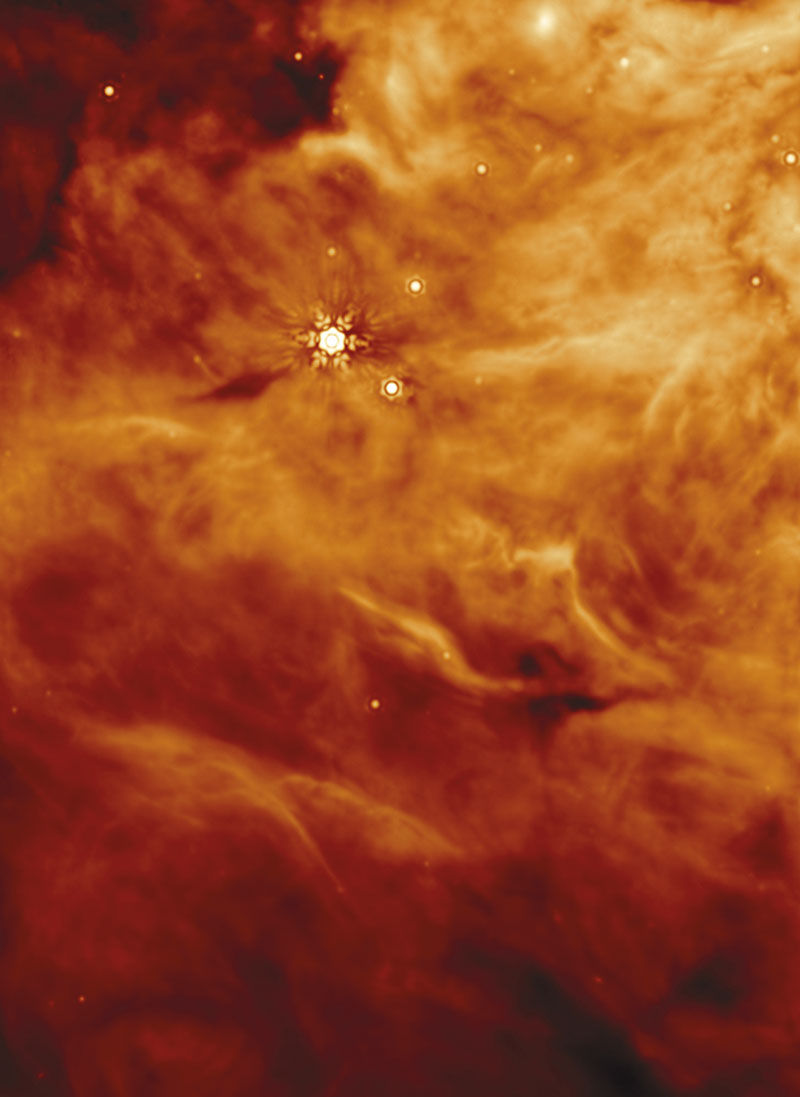
NASA, ESA, CSA, W.R.M. Rocha / LeidenInfrared image, captured by the James Webb Space Telescope, of the region around protostar IRAS 23385NASA, ESA, CSA, W.R.M. Rocha / Leiden
Complex organic molecules considered ingredients of the chemical reactions that may lead to the emergence of life have been identified for the first time in ice fields around two nascent stars. This type of compound, made up of at least six atoms containing carbon, oxygen, and hydrogen, had already been found in a gaseous state in other protostars in the early beginnings of their formation and which do not yet have planets around them. Their detection in solid form had been foreseen in laboratory experiments, but was never unequivocally achieved through astronomical observations. Now, according to a March article in the journal Astronomy & Astrophysics, the chemical signature of at least three complex organic molecules was observed, with no margin for doubt, in stars IRAS 2A and IRAS 23385. The first is 975 light-years from Earth, and the second just 16,000 light-years away.
The most well-known molecule identified was ethanol (CH3CH2OH), the ethyl alcohol used in beer, wine, and other beverages. Another one, reasonably well known, was acetaldehyde (CH3CHO), one of the agents responsible for the hangover feeling after excessive drinking. The third compound identified is less familiar: methyl methanoate (CH3OCHO), which can be used as a cellulose acetate solvent and insecticide. To a lesser degree of certainty, the interstellar ice was also found to contain acetic acid (CH3COOH), the main ingredient of vinegar.
“The article demonstrates that complex organic molecules can form in the ice around protostars. Several laboratory studies had suggested that this was possible, but there was no observation proving the idea,” explains Brazilian astrophysicist Will Rocha, lead author of the piece, currently conducting postdoctoral work at Leiden University in the Netherlands. “Contained in the ice as they are, these molecules would have less chance of being destroyed by radiation, and could survive the evolutionary process of a protostar.” Thus, in theory, they could be present in planets in formation, and serve as raw material to form the molecules necessary for the emergence of life, such as amino acids.
The presence of these molecules was registered by one of the spectrographs aboard the James Webb Space Telescope (JWST), a joint project between the NASA, European ESA, and Canadian (CSA) space agencies. This type of instrument disperses light emitted by an astrophysical object and enables inferences to be drawn about its chemical composition, among other parameters.
According to astrophysicist Sergio Pilling, coordinator of the Astrochemistry and Astrobiology Laboratory at Vale do Paraíba University (UNIVAP), the study reinforces the hypothesis that certain complex organic chemicals occur in frozen form before being incorporated into the gaseous phases, or even within the planetary bodies. “Understanding the abundance and distribution of these molecules in space may provide insights into the potential habitability of other planets,” says Pilling, who did not participate in the study team. One of the nascent stars, IRAS 2A, has a similar appearance to the Sun at the beginning of its existence, and could be useful for understanding its origin.
Scientific article
ROCHA, W.R.N. et al. JWST Observations of Young protoStars (JOYS+): Detecting icy complex organic molecules and ions. Astronomy & Astrophysics. mar. 13, 2024.